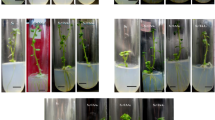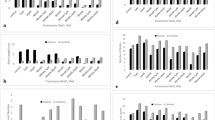Abstract
The present investigation envisaged revealing the role of exogenous application of ascorbic acid in increasing resistance against NaCl stress. Shoot apices from 60-d-old, in vitro-grown plants of two commercially important cultivars of Solanum tuberosum L., cvs. Desiree and Cardinal, were inoculated on Murashige and Skoog (MS) medium supplemented with 0.5 mM ascorbic acid for 72 h as a pretreatment. Pretreated and non-pretreated shoot apices were transferred to MS medium containing different concentrations of NaCl (0–140 mM; eight treatments). Results were recorded for morphological (shoot length, shoot number, root length, root number, and number of nodes) and biochemical features (protein, peroxidase, catalase, and superoxide dismutase activities) after 60 d of salt treatment. Similarly, 60-d-old, well-proliferated callus cultures were also pretreated with ascorbic acid for 24 h and transferred to an optimized callus proliferation medium containing different concentrations of salt. Results were recorded after 60 d of salt treatment for percentage relative fresh weight growth and biochemical parameters. Salinity severely inhibited all the growth parameters in both the cultivars. Pretreatment with ascorbic acid to both salt-treated plants and callus cultures showed significant differences with respect to almost all of the growth and biochemical parameters studied. Protein content as well as catalase and superoxide dismutase activities increased significantly in both the cultivars, although peroxidase activity showed a decreasing trend in ascorbic acid-pretreated plants as well as callus cultures.


Similar content being viewed by others
References
Agastian P.; Kingsley S. J.; Vivekanandan M. Effect of salinity on photosynthesis and biochemical characteristics in mulberry genotypes. Photosynthesis 38: 287–290; 2000.
Al-Hakimi A. M. A.; Hamada A. M. Counteraction of salinity stress on wheat plants by grain soaking in ascorbic acid, thiamin or sodium salicylate. Biol. Plant. 44(2): 253–261; 2001.
Asada K. Ascorbate peroxidase a hydrogen peroxide scavenging enzyme in plants. Physiol. Plant. 85: 235–241; 1992.
Ashraf M.; Foolad R. M. Pre-sowing seed treatment: a shotgun approach to improve germination, plant growth and crop yield under saline and non-saline conditions. Adv. Agron. 88: 223–271; 2005.
Ashraf M.; Harris P. J. C. Potential biochemical indicators of salinity tolerance in plants. Plant Sci. 166(1): 3–16; 2004.
Azevedo-Neto A. D.; Jose T. P.; Joaquim E. F.; Carlos E. B. A.; Eneas G. F. Effect of salt stress on antioxidative enzymes and lipid peroxidation in leaves and roots of salt-tolerant and salt-sensitive maize genotypes. Environ. Experi. Bot. 56: 87–94; 2006.
Azooz M. M.; Shaddad M. A.; Abdel-Latef A. A. The accumulation and compartmentation of proline in relation to salt tolerance of three sorghum cultivars. Ind. J. Plant Physiol. 9: 1–8; 2004.
Beers R. F.; Sizer I. W. A spectrophotometric method for measuring the breakdown of hydrogen peroxide by catalase. J. Biol. Chem. 195: 133–140; 1952.
Benavides M. P.; Marconi P. L.; Gallego S. M.; Comba M. E.; Tomaro M. L. Relationship between antioxidant defense systems and salt tolerance in Solanum tuberosum. Aust. J. Plant Physiol. 27: 273–278; 2000.
Cheeseman J. M. Mechanism of salinity tolerance in plants. Plant Physiol. 87: 547–550; 1988.
Cherian S.; Reddy M. P.; Pandya J. B. Studies on salt tolerance in Avicennia marina (Forstk) vierh: effect of NaCl salinity on growth, ion accumulation and enzyme activity. Ind. J. Plant Physiol. 4: 266–270; 1999.
Chiru S. C.; Gheorghe O.; Paul C. S. Preface of the special issue 31(3/4): potato in a changing world. Potato Res. 51: 215–216; 2008.
Citterio S.; Sgorbati S.; Scippa S.; Sparvoli E. Ascorbic acid effect on the onset of cell proliferation in pea root. Physiol. Plant. 92: 601–607; 1994.
Croughan T. P.; Stavarek S. J.; Rains D. W. In vitro development of salt resistant plants. J. Experi. Bot. 24: 317–324; 1981.
Ekanayake I. J.; Dodds J. H. In vitro testing for the effects of salt stress on growth and survival of sweet potato. Scientia. Hortic. 55(3): 239–248; 1993.
F.A.O. Global network on integrated soil management for sustainable use of salt-affected soils. Rome, Italy: land and plant nutrition management services. http://www.fao.org/ag/agl/agll/spush 2005.
Farhatullah; Rashid M.; Raziuddin. In vitro effect of salt on the vigor of potato (Solanum tuberosum L) plantlets. Biotech 1(2–4): 73–77; 2002.
Fidalgo F.; Santos A.; Santos I.; Salema R. Effect of long-term salt stress on antioxidant defense system, leaf water relations and chloroplast ultra-structure of potato plant. Ann. Appl. Biol. 145: 185–192; 2004.
Gadallah M. A. A. Effects of acid mist and ascorbic acid treatment on the growth, stability of leaf membranes, chlorophyll content and some mineral elements of Carthamus tinctorius, the safflower. Water Air Soil Pollut. 118: 311–327; 2000.
Harinasut P.; Darinee P.; Kannarat R.; Rangsi C. Salinity effects on antioxidant enzymes in mulberry cultivar. Sci. Asia. 29: 109–113; 2003.
Heber U.; Miyake C.; Mano J.; Ohno C.; Asada K. Monodehydroascorbate radical detected by electron paramagnetic resonance spectrometry is sensitive probe of oxidative stress in intact leaves. Plant Cell Physiol. 37: 1066–1072; 1996.
Hernandez J. A.; Olmos E.; Corpas F. J.; Sevilla F.; Del-Rio L. A. Salt induced oxidative stress in chloroplast of pea plant. Plant Sci. 105: 151–167; 1995.
Jaleel C. A.; Gopi R.; Manivannan P.; Panneerselvam R. Antioxidative potentials as a protective mechanism in Catharanthus roseus (L.) G. Don. Plants under salinity stress. Turk J. Bot. 31: 245–251; 2007.
Karimi G.; Ghorbanli M.; Heidari H.; Khavari Nejad R. A.; Assareh M. H. The effect of NaCl on growth, water relation, osmolyte and ion content in Kochia prostrata. Biol. Plant. 49(2): 301–304; 2005.
Khan M. A.; Ahmad M. Z.; Hameed A. Effect of sea salt and l-ascorbic acid on the seed germination of halophytes. J. Arid Environ. 67: 535–540; 2006.
Luck H. Methods in enzymatic analysis. 2nd ed. Bergmeyer Academic, New York, p 885; 1974.
Maral J.; Puget K.; Michelson A. M. Comparative study of superoxide dismutase, catalase and glutathione peroxidase levels in erythrocytes of different animals. Biochem. Biophys. Res. Commun. 77: 1525–1535; 1977.
Martinez C. A.; Moacyr M.; Elisonete G. L. In vitro salt tolerance and proline accumulation in Andean potato (Solanum spp.) differing in frost resistance. Plant Sci. 116: 177–184; 1996.
Mckenzie R. C. Tolerance of plants to soil salinity. Proceedings of the dry land salinity control Workshop, Calgary, Alberta Agriculture, Food and Rural Development, Conservation and Development Branch, pp 245–251; 1988.
Mittova V.; Tal M.; Volokita M.; Guy M. Up-regulation of the leaf mitochondrial and peroxisomal antioxidative system in response to salt-induced oxidative stress in the wild salt tolerant tomato species Lycopersicon pennellii. Plant Cell. Environ. 26: 845–856; 2003.
Molassiotis A. N.; Sotiropoulos T.; Tanou G.; Kofidis G.; Diamantidis G.; Therios I. Antioxidant and anatomical responses in shoot culture of the apple rootstock MM 106 treated with NaCl, KCl, mannitol or sorbitol. Biolog. Plant. 50(1): 61–68; 2006.
Murashige T.; Skoog F. A revised medium for rapid growth and bioassays with tobacco tissue cultures. Physiol. Plant. 15: 473–497; 1962.
Muthukumarasamy M.; Dutta-Gupta S.; Panneerselvam R. Enhancement of peroxidase, polyphenol oxidase and superoxide dismutase activities by triadimefon in NaCl stressed Raphanus sativus L. Biol. Plant. 43: 317–320; 2000.
Nakano Y.; Asada K. Hydrogen peroxide is scavenged by ascorbate-specific peroxidase in spinach chloroplast. Plant Cell Physiol. 22: 867–880; 1981.
Noctor G.; Foyer C. H. Ascorbate and glutathione: keeping active oxygen under control. Annu. Rev. Plant. Physiol. Plant Mol. Biol. 49: 249–279; 1998.
Prescott A. G.; John P. Dioxygenases: molecular structure and role in metabolism. Annu. Rev. Plant Physiol. Plant Mol. Biol. 47: 245–271; 1996.
Racusen D.; Johnstone D. B. Estimation of protein in cellular material. Nature 191: 292–493; 1961.
Rahnama H.; Ebrahimzadeh E.; Ghareyazie B. Antioxidant enzymes responses to NaCl stress in calli of four potato cultivars. Pak. J. Bot. 35: 579–586; 2003.
Reddy A. R.; Chiatanya K. V.; Vivekanadan M. Drought induced responses of photosynthesis and antioxidant metabolism in higher plants. J. Plant Physiol. 161: 1189–1202; 2004.
Sairam R. K.; Srivastava G. C.; Agarawal S.; Meena R. C. Differences in antioxidant activity in response to salinity stress in tolerant and susceptible wheat genotypes. Biol. Plant. 49(1): 85–91; 2005.
Sasikala D. P. P.; Prasad P. V. D. Influence of salinity on auxiliary bud cultures of six low land tropical cultivar of potato (Solanum tuberosum). Plant Cell Tiss. Org. Cult. 32: 185–191; 1993.
Shalata A.; Neumann P. M. Exogenous ascorbic acid (vitamin C) increases resistance to salt and reduce lipid peroxidation. J. Exp. Bot. 52: 2207–2211; 2001.
Shigeoka S.; Takahiro I.; Masahiro T.; Yoshiko M.; Toru T.; Yukinori Y.; Kazuya Y. Regulation and function of ascorbate peroxidase isoenzymes. J. Exp. Bot. 53: 1305–1319; 2002.
Smirnoff N. Ascorbate, tocopherol and cartenoids: metabolism, pathway engineering and functions. In: Smirnoff (ed) Antioxidants and reactive oxygen species in plants. Blackwell, Oxford, pp 53–86; 2005.
Sreenivasulu N.; Grimm B.; Wobus U.; Weschke W. Differential response of antioxidant compounds to salinity stress in salt-tolerant and salt-sensitive seedlings of foxtail millet. Physiol. Plant. 109: 435–442; 2000.
Vaidyanathan H.; Sivakumar P.; Chakarbrti R.; Thomas G. Scavenging of reactive oxygen species in NaCl stressed rice (Oryza sativa.) differential response in salt tolerant and sensitive varieties. Plant Sci. 165: 1411–1418; 2003.
Wahid A.; Ghazanfar A. Possible involvement of some secondary metabolites in salinity tolerance of sugarcane. J. Plant Physiol. 163: 723–730; 2006.
Wahid A.; Perveen M.; Gelani S.; Basra S. M. A. Pretreatment of seed with H2O2 improves salt tolerance of wheat seedlings by alleviation of oxidative damage and expression of stress proteins. J. Plant Physiol. 164: 283–294; 2007.
Yu B. P. Cellular defenses against damage from reactive oxygen species. Physiol. Rev. 74: 139–162; 1994.
Acknowledgment
Financial support to F.A by Higher Education Commission (HEC project 20-143) is gratefully acknowledged.
Author information
Authors and Affiliations
Corresponding author
Additional information
Editor: Woong-Young Soh
Rights and permissions
About this article
Cite this article
Sajid, Z.A., Aftab, F. Amelioration of salinity tolerance in Solanum tuberosum L. by exogenous application of ascorbic acid. In Vitro Cell.Dev.Biol.-Plant 45, 540–549 (2009). https://doi.org/10.1007/s11627-009-9252-4
Received:
Accepted:
Published:
Issue Date:
DOI: https://doi.org/10.1007/s11627-009-9252-4




